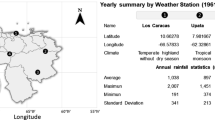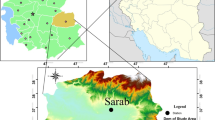Abstract
This paper proposes a new hybrid approach I-WT-LSTM (i.e., Improved Wavelet Long Short-Term Memory (LSTM) Model) for forecasting non-stationary time series (TS) from satellite imagery. The proposed approach consists of two steps: The first step aims at decomposing TS using Multi-Resolution Analysis wavelet (MRA-WT) into inter-and intra-annual components using 18 different mother wavelets (MW). Then, the energy to Shannon entropy ratio criterion is calculated to select the best MW. The second step is based on the LSTM model using Adam optimizer to predict the future. The proposed approach is tested using TS derived from Moderate Resolution Imaging Spectroradiometer (MODIS) images from 2001 to 2017. The results were compared with the predictions of the LSTM models using different optimizers. Additionally, the importance of selecting the optimal MW is analysed. The obtained results prove that the I-WT-LSTM approach outperforms all other methods.
Access this chapter
Tax calculation will be finalised at checkout
Purchases are for personal use only
Similar content being viewed by others
References
Phan, D.H., Huynh, L.D.: Evaluation of the cleft-overstep algorithm for linear regression analysis. In: Nguyen, N.T., Hoang, B.H., Huynh, C.P., Hwang, D., Trawiński, B., Vossen, G. (eds.) ICCCI 2020. LNCS (LNAI), vol. 12496, pp. 400–411. Springer, Cham (2020). https://doi.org/10.1007/978-3-030-63007-2_31
Rhif, M., Ben Abbes, A., Martinez, B., Farah, I.R.: A deep learning approach for forecasting non-stationary big remote sensing time series. Arab. J. Geosci. 13(22), 1–11 (2020). https://doi.org/10.1007/s12517-020-06140-w
Huang, N., Shen, Z., Steven, L., et al.: The empirical mode decomposition and the Hilbert spectrum for nonlinear and non-stationary time series analysis. In: Proceedings of the Royal Society of London. Series A: Mathematical, Physical and Engineering Sciences 454(1971), 903–995 (1998). https://doi.org/10.1098/rspa.1998.0193
Chang, Z., Zhang, Y., Chen, W.: Electricity price prediction based on hybrid model of adam optimized LSTM neural network and wavelet transform. Energy 187, 115804 (2019)
Zhang, Q., Li, F., Long, F., Ling, Q.: Vehicle emission forecasting based on wavelet transform and long short-term memory network. IEEE Access 6, 56984–56994 (2018)
Li, Z., Tam, V.: Combining the real-time wavelet denoising and long-short-term-memory neural network for predicting stock indexes. In: 2017 IEEE Symposium Series on Computational Intelligence (SSCI), pp. 1–8. IEEE (2017)
Rhif, M., Abbes, A.B., Farah, I., Martinez, B., Sang, Y.: Wavelet transform application for/in non-stationary time-series analysis: a review. Appl. Sci. 9(7), 1345 (2019). https://doi.org/10.3390/app9071345
Rouse Jr, J., Haas, R., Schell, J., Deering, D.: Monitoring vegetation systems in the great plains with ERTS. In: Third Earth Resources Technology Satellite–1 Syposium 1, pp. 309–317 (1974)
Xue, J., Su, B.: Significant remote sensing vegetation indices: a review of developments and applications. J. Sens. 2017 (2017)
Abbes, A.B., Farah, M., Farah, I., Barra, V.: A non-stationary NDVI time series modelling using triplet Markov chain. Int. J. Inf. Dec. Sci. 11(2), 163–179 (2019)
Martínez, B., Gilabert, M.: Vegetation dynamics from NDVI time series analysis using the wavelet transform. Remote Sens. Environ. 113(9), 1823–1842 (2009). https://doi.org/10.1016/j.rse.2009.04.016
Abbes, A.B., Bounouh, O., Farah, I., de Jong, R., Martínez, B.: Comparative study of three satellite image time-series decomposition methods for vegetation change detection. Eur. J. Remote Sens. 51(1), 607–615 (2018). https://doi.org/10.1080/22797254.2018.1465360
Rhif, M., Ben Abbes, A., Martínez, B., Farah, I.: Deep learning models performance for NDVI time series prediction: a case study on north west Tunisia. In: 2020 Mediterranean and Middle-East Geoscience and Remote Sensing Symposium (M2GARSS), pp. 9–12. IEEE (2020)
Ghaderpour, E., Ben Abbes, A., Rhif, M., Pagiatakis, S.D., Farah, I.R.: Non-stationary and unequally spaced NDVI time series analyses by the lSWAVE software. Int. J. Remote Sens. 41(6), 2374–2390 (2020)
Rodrigues, A., Daazmello, G., et al.: Selection of mother wavelet for wavelet analysis of vibration signals in machining. J. Mech. Eng. Autom. 6(5A), 81–85 (2016)
Reddy, D., Prasad, P.: Prediction of vegetation dynamics using NDVI time series data and LSTM. Model. Earth Syst. Environ. 4(1), 409–419 (2018)
Kingma, D., Ba, J.: Adam: a method for stochastic optimization. arXiv preprint arXiv:1412.6980 (2014)
Rafiei, M., Niknam, T., Aghaei, J., Shafie-Khah, M., Catalão, J.P.: Probabilistic load forecasting using an improved wavelet neural network trained by generalized extreme learning machine. IEEE Trans. Smart Grid 9(6), 6961–6971 (2018)
Mallat, S.: A theory for multiresolution signal decomposition: the wavelet representation. IEEE Trans. Pattern Anal. Mach. Intell. 11(7), 674–693 (1989). https://doi.org/10.1109/34.192463
Jawerth, B., Sweldens, W.: An overview of wavelet based multiresolution analyses. SIAM Rev. 36(3), 377–412 (1994)
Percival, D.B., Wang, M., Overland, J.E.: An introduction to wavelet analysis with applications to vegetation time series. Community Ecol. 5(1), 19–30 (2004). https://doi.org/10.1556/ComEc.5.2004.1.3
Su, W., Qu, Y., Deng, C., Wang, Y., Zheng, F., Chen, Z.: Enhance generative adversarial networks by wavelet transform to denoise low-dose CT images. In: 2020 IEEE International Conference on Image Processing (ICIP), pp. 350–354. IEEE (2020)
Hochreiter, S., Schmidhuber, J.: Long short-term memory. Neural Comput. 9(8), 1735–1780 (1997)
Author information
Authors and Affiliations
Corresponding author
Editor information
Editors and Affiliations
Rights and permissions
Copyright information
© 2021 Springer Nature Switzerland AG
About this paper
Cite this paper
Rhif, M., Abbes, A.B., Martinez, B., Farah, I.R. (2021). An Improved Forecasting Model from Satellite Imagery Based on Optimum Wavelet Bases and Adam Optimized LSTM Methods. In: Nguyen, N.T., Iliadis, L., Maglogiannis, I., Trawiński, B. (eds) Computational Collective Intelligence. ICCCI 2021. Lecture Notes in Computer Science(), vol 12876. Springer, Cham. https://doi.org/10.1007/978-3-030-88081-1_42
Download citation
DOI: https://doi.org/10.1007/978-3-030-88081-1_42
Published:
Publisher Name: Springer, Cham
Print ISBN: 978-3-030-88080-4
Online ISBN: 978-3-030-88081-1
eBook Packages: Computer ScienceComputer Science (R0)




